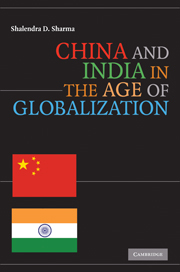Book contents
- Frontmatter
- Contents
- Acknowledgments
- Acronyms
- Political Map of China
- Political Map of India
- Introduction: China and India in the Age of Globalization
- 1 Prelude to Globalization: China (1949–1978) and India (1947–1991)
- 2 China and India Embrace Globalization
- 3 China: Strategies and Patterns of Global Integration
- 4 India: Strategies and Patterns of Global Integration
- 5 Sino-Indian Relations: Partners, Friends, or Rivals?
- 6 India and the United States: From Estrangement to Engagement
- 7 The Rise of China and Its Implications for the United States
- 8 China and India: Future Challenges and Opportunities
- Bibliography
- Index
6 - India and the United States: From Estrangement to Engagement
Published online by Cambridge University Press: 22 January 2010
- Frontmatter
- Contents
- Acknowledgments
- Acronyms
- Political Map of China
- Political Map of India
- Introduction: China and India in the Age of Globalization
- 1 Prelude to Globalization: China (1949–1978) and India (1947–1991)
- 2 China and India Embrace Globalization
- 3 China: Strategies and Patterns of Global Integration
- 4 India: Strategies and Patterns of Global Integration
- 5 Sino-Indian Relations: Partners, Friends, or Rivals?
- 6 India and the United States: From Estrangement to Engagement
- 7 The Rise of China and Its Implications for the United States
- 8 China and India: Future Challenges and Opportunities
- Bibliography
- Index
Summary
To a generation of India's leaders, their country's economic backwardness and grinding poverty was not only a source of enormous embarrassment, it also stood as an obstacle to the international prestige and respect that they craved and believed was India's natural geopolitical destiny. India's unprecedented economic rise has finally made this dream a possibility. Its leaders realize that after decades of tireless effort to overcome the long history of thwarted ambitions, power and prestige are now tantalizingly within the country's reach. Slowly but surely, India is finally acquiring the capability to influence developments – not only in the South Asian region but throughout the world.
This chapter provides an assessment of the economic and geostrategic implications for the United States of India's rise. It examines the evolving relations between the two countries over the past six decades, highlighting the twists and turns in a complex relationship. In the post–Cold War period, the relations between the world's most powerful democracy and the world's largest democracy have improved dramatically, leading some to conclude that Indo-U.S. relations have finally moved from “estrangement to engagement,” and others to suggest blissfully the flowering of a “beautiful friendship” (Ganguly, Shoup, and Scobell 2006; Kux 1992).Yet this chapter argues that although there is currently strong convergence of American and Indian interests on a number of economic and security areas, including the promotion of democracy and countering terrorism and extremism, Indo-U.S. relations will not be without friction.
- Type
- Chapter
- Information
- China and India in the Age of Globalization , pp. 185 - 210Publisher: Cambridge University PressPrint publication year: 2009



